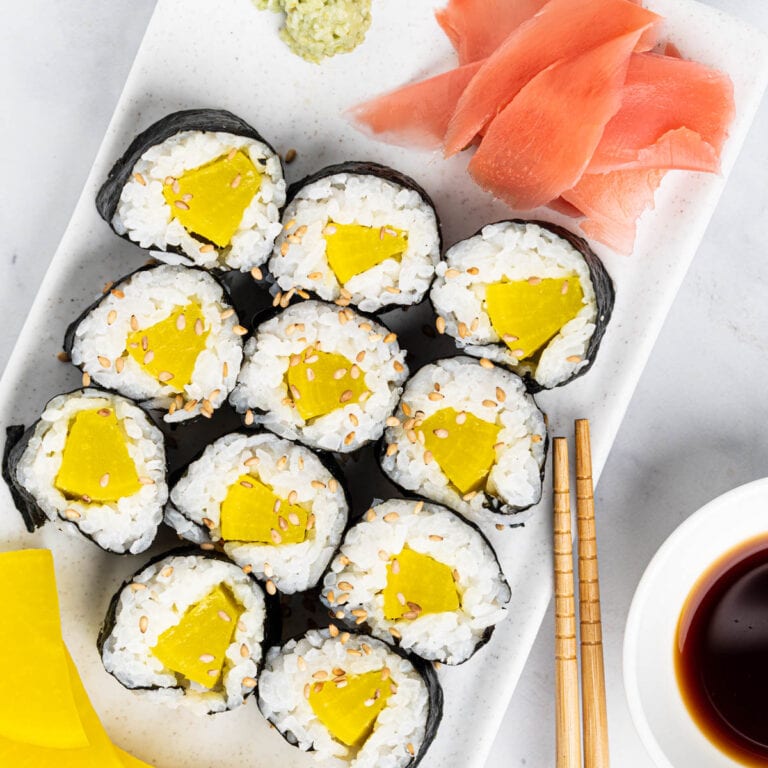What is Yamagobo | Easy Yamagobo Recipe
A guide to yamagobo (Japanese pickled burdock root) and a simple 5-ingredient recipe for homemade yamagobo.

What is yamagobo?
Yamagobo, also known as pickled burdock root, is a popular ingredient in Japanese cuisine. It is made by pickling burdock root in a mixture of sugar, vinegar, and other seasonings. The burdock root is first sliced thinly and then marinated to absorb the flavors of the pickling liquid.

Burdock root, the main ingredient of yamagobo, is a long and slender root vegetable that is native to Eurasia. It has a mild, slightly sweet, and earthy flavor. Burdock root is known for its crunchy texture and is often used in various culinary preparations in Japanese, Korean, and other Asian cuisines.
Yamagobo is commonly used as a condiment or garnish in Japanese dishes. It is frequently seen as an accompaniment in sushi rolls, adding a touch of crunchiness and a unique flavor profile to the overall taste. It can also be enjoyed on its own as a side dish or added to salads for an interesting twist.
Overall, yamagobo is a delicious and versatile ingredient that adds a delightful taste and texture to a range of Japanese dishes.
What does yamagobo taste like?
Yamagobo has a distinct flavor profile. It is often described as mildly sweet, earthy, and slightly tangy. The pickling process gives it a unique balance of flavors.

The sweetness in yamagobo comes from the addition of sugar in the pickling liquid, which helps to counterbalance the earthy and slightly bitter taste of the burdock root. The earthiness is a characteristic feature of burdock root itself and is reminiscent of other root vegetables.
The tanginess in yamagobo is derived from the vinegar used in the pickling process. It adds a subtle acidic note that complements the other flavors and provides a slight tangy kick.
In terms of texture, yamagobo is crunchy and firm. The pickling process preserves its natural crispness, making it enjoyable to bite into.
Overall, yamagobo offers a unique combination of sweet, earthy, tangy, and crunchy elements, making it a flavorful and interesting ingredient in Japanese cuisine.
Where to buy yamagobo
Yamagobo, or pickled burdock root, can be found in several places. Here are some common places where you can buy yamagobo:
- Asian Grocery Stores: Yamagobo is a staple ingredient in Japanese cuisine, so Asian grocery stores, particularly those specializing in Japanese products, are likely to carry it. Look for the pickled vegetable section or the sushi ingredients aisle.
- Japanese Specialty Stores: Stores that specifically focus on Japanese products, such as Japanese supermarkets or specialty food stores, are a good bet for finding yamagobo. These stores often have a wide range of Japanese ingredients and condiments.
- Online Retailers: Numerous online retailers and e-commerce platforms offer a wide selection of Japanese ingredients, including yamagobo. Popular online marketplaces like Amazon, Japanese food specialty websites, or Asian grocery delivery services may have yamagobo available for purchase. It might be cheaper to buy locally, to avoid shipping costs.
- Local Sushi Restaurants or Japanese Delis: Some sushi restaurants or Japanese delis may sell yamagobo as a separate item. You can inquire at your local Japanese food establishments to see if they offer pickled burdock root for sale.
- Farmers’ Markets: Depending on your location, you might find yamagobo at farmers’ markets that feature Asian produce or specialty vendors. It’s worth checking local farmers’ markets for fresh or pickled burdock root.
When purchasing yamagobo, ensure to check the packaging for quality, expiration dates, and any specific storage instructions. Remember that availability may vary depending on your location and the availability of Japanese ingredients in your area.
How to select the best burdock root
When selecting burdock root, keep the following tips in mind to choose the best quality:

- Look for Freshness: Choose burdock roots that appear fresh and vibrant. Fresh burdock roots should have a firm texture and not feel soft or mushy. Avoid roots that have wrinkled or shriveled skin, as this could indicate dehydration or age.
- Check for Blemishes: Inspect the surface of the burdock root for any visible blemishes, spots, or discoloration. Ideally, the skin should be smooth and free from cuts or bruises.
- Assess Size and Shape: Select burdock roots that are medium to large in size, as they tend to have a better flavor and texture. Look for roots that are straight and uniform in shape, without any unusual bends or twists.
- Consider Weight: Pick up the burdock root and feel its weight. It should feel relatively heavy for its size, indicating moisture content and freshness.
- Skin Quality: The skin of burdock root should be dark brown or blackish, indicating maturity. Avoid roots with excessively pale or greenish skin, as they may be underripe.
- Smell: Burdock root should have a mild, earthy aroma. If it emits any foul or unpleasant odor, it may indicate spoilage.
How to cut gobo (burdock root)


- Rinse the burdock root thoroughly under cold water to remove any dirt or debris.
- Use a vegetable peeler or a paring knife to remove the outer skin of the burdock root. Gently peel the skin away, similar to how you would peel a carrot. The skin is tough, so be careful while peeling.
- Once the burdock root is peeled, you can cut it into the desired shape and size. Here are a few common cutting methods:
- Thin Slices: If you want thin slices of burdock root, use a sharp knife to cut it into thin, even rounds. This is often used for making yamagobo or adding burdock root to stir-fries or other dishes.
- Julienne or Matchsticks: To create matchstick-shaped pieces, slice the burdock root into thin strips, about 2-3 inches in length. These matchstick-sized pieces are commonly used in stir-fries, salads, or for pickling.
- Chunks or Batons: If you prefer larger pieces, cut the burdock root into shorter, chunky batons. This is useful when using burdock root in soups or stews.
- As you cut the burdock root, you may notice that it has a tendency to darken upon exposure to air. To prevent discoloration, you can soak the cut burdock root in water with a little bit of vinegar or lemon juice. If you are pickling it, place it directly into the pickle mixture.
Yamagobo Ingredients

You can make your own yamagobo with a few simple ingredients:
- Burdock root (gobo): you can find this at your local Asian or Japanese specialty store in the produce section.
- Rice vinegar: used to pickle the gobo.
- Sugar: for added sweetness and to balance out the tanginess.
- Salt/Soy sauce: used to add saltiness to the pickling juice.
- Water: add more water, if needed, to fully submerge the burdock root.
- Carrot powder or red/orange food coloring: using carrot powder or food coloring will give yamagobo it’s classic color since burdock root is naturally white. This is totally optional and it won’t affect the taste.
How to make yamagobo (Japanese pickled burdock)

Step 1: In a jar, combine hot water and sugar. Mix until the sugar dissolves. Then, stir in the rice vinegar, soy sauce, and salt. Set aside and let the mixture cool down.
Step 2: Peel and cut the burdock root into sticks. Put it into the jar and add more water, if needed, until the burdock root is fully submerged.
Step 3: Store in the fridge for up to 2 months.
How to serve yamagobo
Yamagobo, or pickled burdock root, can be served in various ways. Here are a few popular serving suggestions:
- Sushi Rolls: Yamagobo is a common ingredient in sushi rolls, particularly in the popular California Roll. It adds a crunchy texture and a unique flavor. Simply place a strip of yamagobo alongside other ingredients such as sushi rice, fish, and vegetables, and roll it up in a sheet of nori (seaweed). Here is an easy gobo sushi recipe.
- Side Dish: Serve yamagobo as a side dish alongside other Japanese dishes. It can be enjoyed on its own, providing a refreshing and tangy element to the meal. You can also serve it with a dipping sauce or alongside other pickled vegetables.
- Salad: Add yamagobo to salads for an interesting twist. Slice or julienne the yamagobo and toss it with mixed greens, your choice of vegetables, and dressing. The pickled flavor and crunch of yamagobo can enhance the overall texture and taste of the salad.
- Bento Box: Include yamagobo in a Japanese-style bento box meal. Place a portion of yamagobo alongside other items like rice, grilled meat or fish, steamed vegetables, and other pickles. It adds color, flavor, and texture to the bento box.
- Garnish: Use yamagobo as a garnish for various dishes. Its vibrant color and unique taste can be used to enhance the visual appeal and flavor profile of a plate. Sprinkle thin slices or strips of yamagobo on top of sushi, noodle dishes, or even soups for an added touch.
How to store yamagobo
Refrigerate
After opening the package or container of yamagobo, store any unused portion in the refrigerator. Place it in an airtight container or resealable plastic bag to prevent exposure to air and moisture. It is best to consume it before the expiration date on the package.
If you have homemade yamagobo that is immersed in pickling liquid, make sure it remains submerged while in storage. The pickling liquid helps preserve the yamagobo and maintains its flavors. Ensure the container is tightly sealed to avoid any leaks.
Generally, pickled burdock root can be stored in the refrigerator for a few weeks to a couple of months.
Freeze (Optional)
If you have a large quantity of yamagobo or want to extend its shelf life further, you can consider freezing it. Transfer the pickled burdock root to an airtight freezer-safe container or freezer bag, removing as much air as possible before sealing. Frozen yamagobo can last for several months, but it’s best to consume it within the first two to three months for the best quality.
Thawing: When you wish to use frozen yamagobo, thaw it in the refrigerator overnight or immerse the container in cold water to speed up the process.

Yamagobo (Japanese Pickled Burdock)
Ingredients
- ½ pound burdock root (gobo)
- ½ cup rice vinegar
- ½ cup sugar
- ½ tablespoon salt
- ½ tablespoon soy sauce
- ⅔ cup hot water (heat in microwave for 1 minute)
- 2 teaspoons carrot powder (or 3-4 drops orange food coloring)
Instructions
- In a jar, combine hot water and sugar. Mix until the sugar dissolves. Then, stir in the rice vinegar, soy sauce, and salt. Set aside and let the mixture cool down.
- Peel and cut the burdock root into sticks. Put it into the jar and add more water, if needed, until the burdock root is fully submerged.
- Store in the fridge for up to 2 months.
Notes
- The warm water is used to dissolve the sugar. Let the pickling juice cool before adding the burdock root.
- Carrot powder or food coloring is added because the root turns brown after some time but it is optional. You do not need to use this and it won’t affect the taste.








Just finishing reading about yamagobo. I always wondered what it was in my sushi and thought it was carrot for some reason. I can’t believe it is super easy to make too. I’m learning something new everyday.
Very interesting! I’ve never heard of this or even seen it anywhere in the US. I’ll have to look for it. Thanks for sharing about it.
I had never heard of this before, but I love trying new things and your recipe was so simple and yummy
Well, learned something new today. I have never heard about yamagobo before. However, we love Japanese food and have a great Asian store near us. So I am off this afternoon to get it because it sounds delcious!
I have never heard of this ingredient before, but I am so interested in trying new foods. Thanks for the great idea. I will be trying this soon.
This was such a unique and unexpected recipe that does not disappoint! Looking forward to giving this a try in a variety of recipes, indeed!